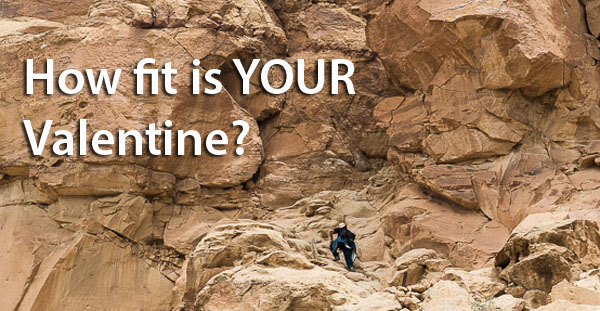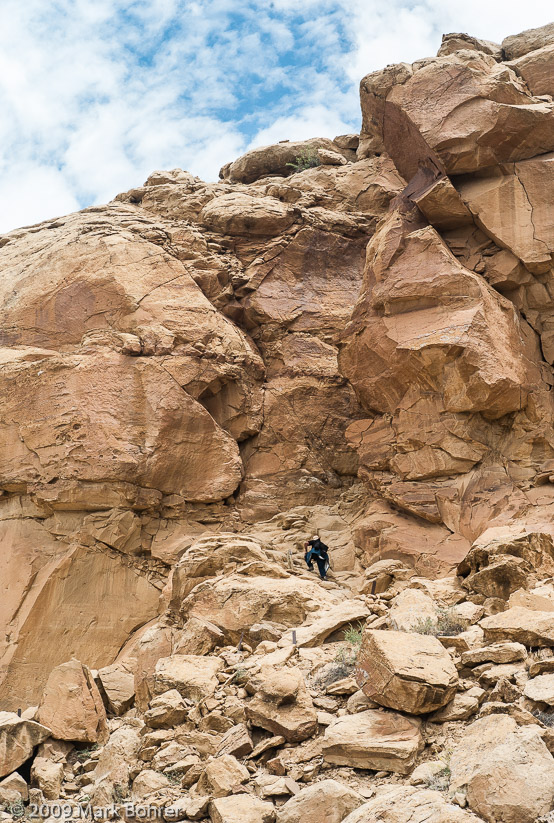Hikes For A Special Day
Valentine’s Day is for candy, flowers, and love, right? Candlelight dinners and champagne? Sweet nothings whispered into your beloved’s ear? The spiritual, artistic petroglyph hike at Piedra MarcadasPetroglyph National Monument is home to over 20,000 petroglyphs, chipped into volcanic caprock mostly between 1300 and 1700. It’s next to a metro area with over 500,000 residents, on Albuquerque’s west side. Yet most of the year, it’s pretty quiet, especially in February. Its Piedras Marcadas unit holds 5,000 pristine petroglyphs, showing anything from quail to mountain lions to dancing shamans to stepped cloud terraces to spirals to kokopellis. There are also Christian crosses, carved by Spanish conquistadores in the 1500s and 1600s to counteract what they saw as pagan magic.
Are the ‘glyphs representations of epic hunts? Pathways to ancestors, near the exit from the previous world? Ancient graffiti? Since we can’t ask the people who carved them, we’ll never know for sure. Even modern Puebloans disagree on their meaning, but do regard the 17-mile escarpment they’re carved on as a holy place, filled with vestiges of their ancestors. The trail at Piedras Marcadas is a level, sandy 1 ½ miles round trip. That may not sound like much, but I’ve spent several hours there just photographing. The psychedelic shapes hike at Tent RocksJust an hour northwest of Albuquerque, there’s a slot canyon rivaling the better-known slots in Arizona and Utah, with just a fraction of their visitors. Ash and pyroclastic flows from the nearby Valles Caldera super volcano hardened in the area over 6 million years or so. The vaguely-phallic cone-shaped rocks eroded out of the underlying sandstone, forming the protected shapes in Kasha-Katuwe Tent Rocks National Monument. The tough love scramble hike behind Chaco’s Kin KletsoThis one sits at the end of a 10-mile stretch of dirt road, the last three of which are unmaintained by San Juan County. That keeps Chaco Culture National Historical Park nearly deserted in winter. Chaco was the center of a flourishing civilization between 880 and 1150, and was sporadically re-occupied until 1300. Ancestral Puebloans built not one but 13 Great Houses there, rising to three and four stories. Imagine quarrying sandstone blocks, cutting and dragging support timbers over 50 miles, and constructing monumental buildings – with no horses, carts, or metal tools.
Shot NotesLift Detail From Petroglyphs
Volcanic rock is dark. But your camera wants everything to be 18% grey. To get it looking the way my eye sees it, I underexpose by 3/4 to 2 stops. Unfortunately, this may also begin to darken the petroglyph too. I fix this in the camera a couple ways. First, I’ll use a polarizing filter in mornings and afternoons when I can get the correct angles for it to work well. Polarizers will increase the contrast in any scene without messing up the colors. The catch is that the sun needs to make a 90-degree angle with the axis your lens points to. They’ll work at other angles, but less well. Finally, when the sun is low on the horizon, they don’t work at all. High Contrast Range In Slot Canyons
I start by shooting in raw format – always. To give a sense of place and depth, I included some sky with the slot canyon shots. The story is about the rock – weird shapes, textures, colors – and the water that sculpted it. That meant holding detail in the shadowed depths of those canyons, close to the rock. This served up a very high contrast range, tough for any camera. Fortunately, modern dSLRs and mirrorless cameras capture up to 14 stops of contrast, versus black and white film’s 8 stops or less. No Urban Exclusion Mode For SlotsI chose a wide 24mm for most shots, since I had enough important detail to fill the frame. I also wanted sharp close-up foregound detail with acceptably-sharp distant background, and the 24mm gives lots of depth of field. For tighter compositions, I picked 42mm-65mm. I used f/10 aperture for adequate depth of field In most cases, and focused on those important foreground details. Why f/10?
With full-frame and especially with APS-C sensors, you start to see sharpness loss from diffraction around f/8 with most lenses. That’s where light diffracted away from the aperture’s edges becomes significant compared to the amount of light heading straight on to the sensor. The diffracted light makes sharp lines in your subject look fuzzy. Stopping down further just makes it worse. |
(408) 483-3782
Curious about how to shoot ruins?(408) 483-3782







Recent Comments